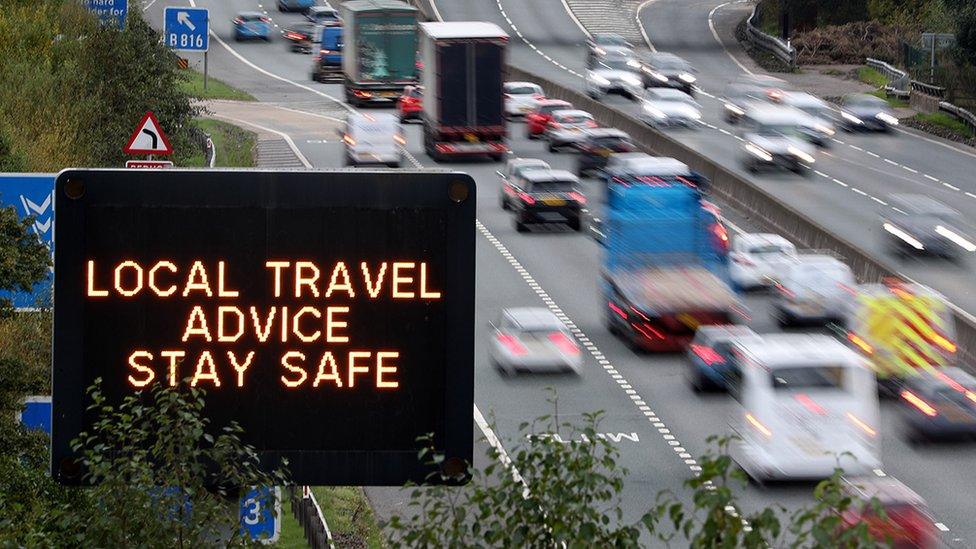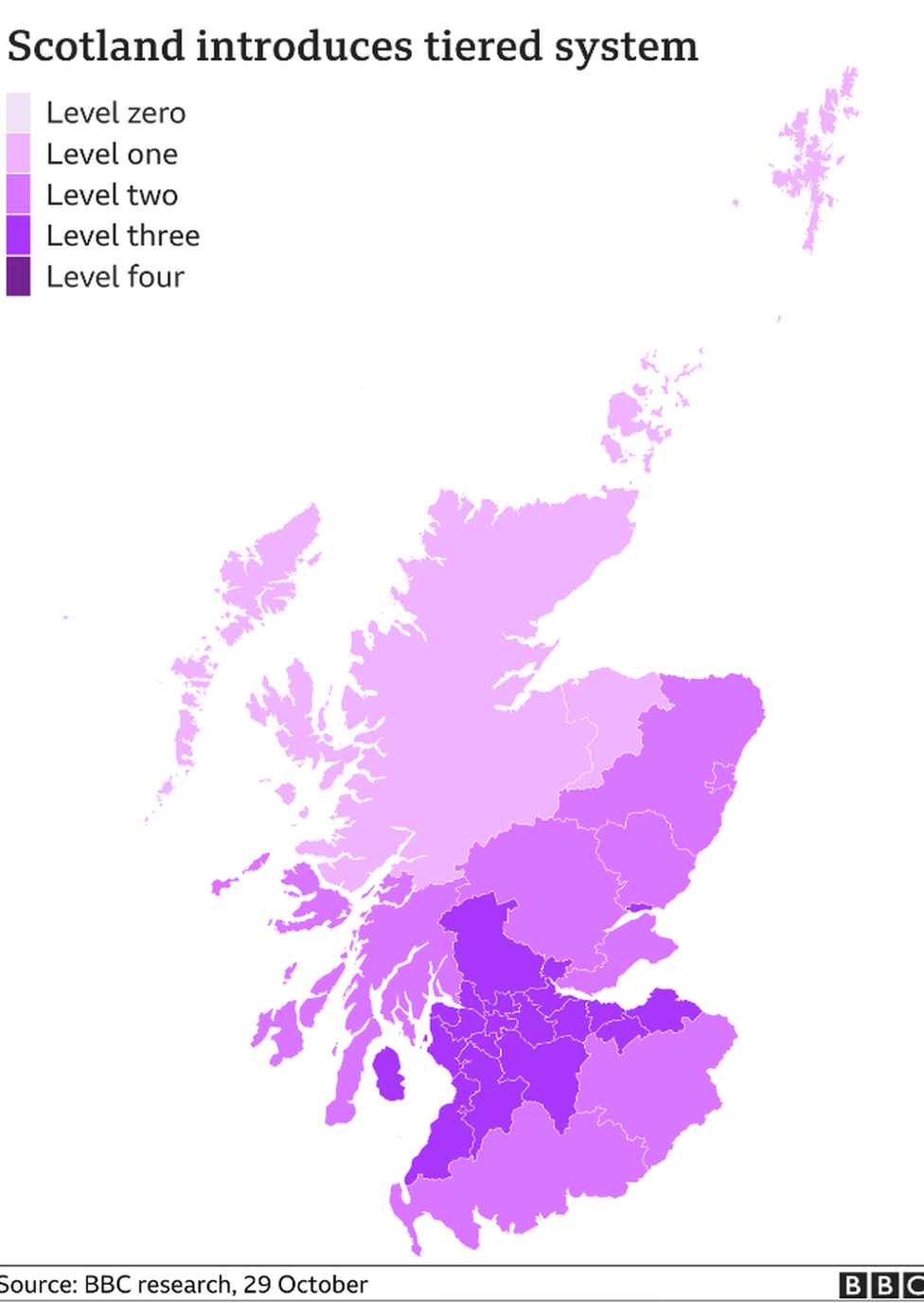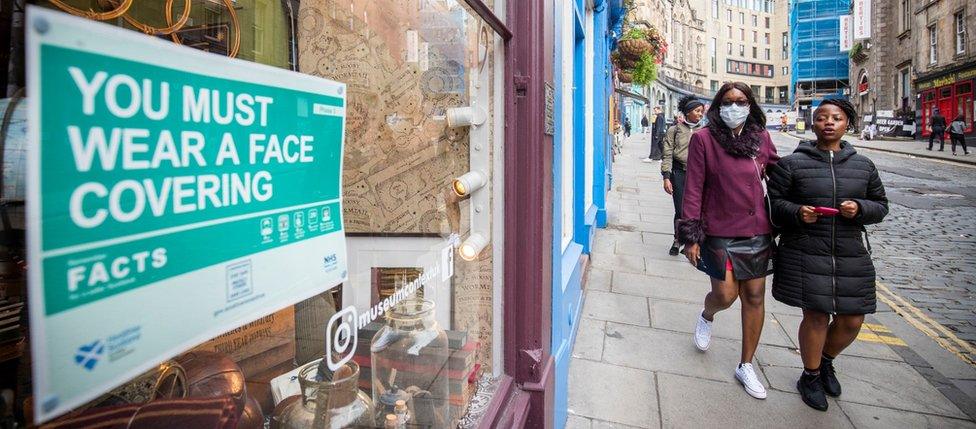Covid in Scotland: New five-level regional restrictions go live
- Published
- comments

People under level 3 restrictions are urged not to make non-essential journeys outside their council areas
Scotland's new Covid restrictions come into force on Monday as England prepares for another national lockdown.
The regional system has five levels but each of the country's 32 local authorities has initially been graded between levels 1 and 3.
People under level 3 restrictions have been told to make only essential journeys outside their council area.
The launch comes amid ongoing calls for clarity from the Treasury over the extension to the furlough scheme.
To prevent any confusion around the local levels a postcode tracker, external has been launched so people can check the regulations - which take effect from 06:00.
Ms Sturgeon said the new system would allow a quick and flexible response, especially in areas where the virus was spreading.
She added: "It's crucial that everyone knows what level their local authority is in and that they stick to the rules in their area.
"The postcode tracker will be a vital tool in helping to ensure this happens."
'Tighter restrictions'
Ms Sturgeon said that while prevalence of the virus was lower in Scotland than in other parts of the UK there could be no room for complacency.
She warned: "No one wants to see tighter restrictions but people can be reassured that, if we need to put in place the protections that come with higher levels, we will not hesitate to do so.
"I also urge everyone to follow two key national restrictions by not mixing with other households inside our homes, and not travelling to or from any part of the country in level 3 unless it is absolutely essential."
Senior school pupils in level 3 areas will also now be required to wear face coverings in class, not just in communal areas.
Deputy first minister John Swinney said students in colleges should do the same as they were in the same "age cohort".
Secondary schools in Dundee are also asking pupils in years S1 to S3 to wear face coverings in the classroom.
Latest figures, external on Sunday revealed there were 1,148 new Covid cases in the previous 24 hours - 7% of those tested - and six further deaths.
A health board breakdown of positive results confirmed NHS Greater Glasgow and Clyde (443 new cases) , NHS Lanarkshire (253) and NHS Lothian (140) remain the major hotspots.
Mr Swinney has said it would be "foolish" to rule out moving to a nationwide lockdown in future if efforts to suppress the virus were unsuccessful.
He told the BBC's Good Morning Scotland: "If we saw a spread of the virus across the country that was not moving in the right direction, then we would of course look to take more acute measures."
On the subject of extended household groups, Mr Swinney said people in level three areas could continue to visit members of the same household, but he would "urge individuals in that situation to exercise the greatest degree of care and caution".

Which level are you in?

Level 3 - Glasgow City, Renfrewshire, East Renfrewshire, East Dunbartonshire, West Dunbartonshire, East Ayrshire, North Ayrshire, South Ayrshire, South Lanarkshire, North Lanarkshire, Inverclyde, City of Edinburgh, Midlothian, East Lothian, West Lothian, Clackmannanshire, Falkirk, Stirling, Dundee.
Level 2 - Aberdeen, Aberdeenshire, Angus, Argyll & Bute, Borders, Dumfries & Galloway, Fife, Perth & Kinross.
Level 1 - Highland, Moray, Orkney, Shetland, Western Isles.

On Saturday, Prime Minister Boris Johnson announced pubs, restaurants, gyms and non-essential shops in England would have to close for four weeks from Thursday to prevent a "medical and moral disaster" for the NHS.
But unlike the restrictions in spring, schools, colleges and universities can stay open.
Cabinet Office minister Michael Gove later conceded the English lockdown may last beyond 2 December.
Nicola Sturgeon and Scottish Conservative leader Douglas Ross have meanwhile both called on the Treasury to provide guarantees relating to the now-extended furlough scheme which pays up to 80% of wages of people unable to work.

They want the same level of support to be available if Scotland has to go into a national lockdown later than England.
Mr Ross has argued the furlough scheme is a "tangible reminder of the economic security of the Union".
He said: "Now that the scheme has been extended to cover the impact of a second lockdown in England, how could a Unionist government not restart the scheme if a second lockdown is required in Scotland?"
Scottish Lib Dem leader Willie Rennie urged the Treasury to be flexible and allow businesses to "pick and choose" when they use it.
The UK Labour leader Sir Keir Starmer has urged a four nations approach for a national lockdown.

Last week Ms Sturgeon confirmed no part of Scotland was being placed in the highest level of the new five-tiered system.
The Scottish government had been considering putting both North and South Lanarkshire in level 4.
But after representations from council leaders both local authorities were graded level 3, along with the rest of the central belt and Dundee.
Much of the rest of the country has been put in level 2.
The Highlands, Orkney, Shetland, the Western Isles and Moray, which have far fewer cases of the virus, have been moved down to level 1.
This could eventually allow groups of up to six people from two households to meet in each other's homes again, although it will not happen immediately as an "extra precaution" while the country transitions to the new system.
The first minister said the levels would be reviewed on a weekly basis with any decisions outlined in parliament on a Tuesday before coming into force the following Friday.
The next update is scheduled for 10 November, with any changes coming into effect on 13 November.


- Published1 November 2020

- Published10 November 2020
